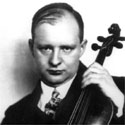|
Neoclassicism, "new classical music," was another form of transitional music in the early 1900s from the romantic
period and part of the impressionist period into more radical styles of composition.
Neoclassical composers used the techniques of classical composers while completely disregarding traditional tonality and harmonies.
The beginning of neoclassicism introduced the ideas of expanded tonality and atonality that would be the structure for most
of the 20th century American musical movements to come.
Stravinsky was one of the most notable 20th century composers and is one of the most recognized because he resided in
America for most of the latter part of his life. He was forced to flee his home multiple times while living in Europe on
the basis of cultural and social controversies. When he came to America, he was able to bring his music which accurately
reflected his life experiences and spread a wealth of new style in the US. Prokofiev, Hindemeth, Strauss and Vaughn Williams
are four other supremely influential composers of the neoclassical period.
Neoromantic was another form of music that paralleled neoclassical music, bridging the gap between romantic music and new
world music, as neoclassical bridged the gap between classical music and new world music.
| Hindemith |

|
|




